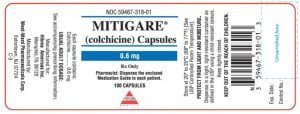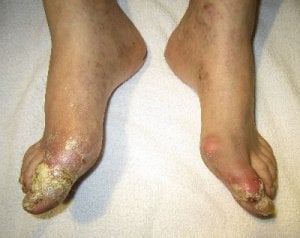Lingering Pain After Gout is my explanation of why you get a flare that seems to last forever. Because when you understand the reasons, it is easier for you to stop it. In particular, I look at how poorly-managed gout happens. Then see what you need to do to avoid residual pain after gout attacks.
Are you clear about stopping gout pain as soon as possible? Or even preventing gout pain?
My 2022 gout pain plan affects some aspects of this article.

Read the Clear Gout Pain Plan now.
Lingering Pain After Gout Audience
I wrote Lingering Pain After Gout mainly for Gout Patients who feel they have done everything right. But find that their gout pain remains after they have taken their usual gout relief scripts. However, it is useful for any gout sufferer who suffers lasting gout symptoms.
If you don’t know what type of gout sufferer you are I suggest you read Questions for Gout Sufferers first.
How Long Can Gout Linger?
Gout studies tell us that gout usually resolves itself in 2 to 5 days[1]. So most gout patients will fill their script for whatever pain relief combo their doctor advises. Then, after a week or less, the pain has gone.
Note, recent science has established that gout pain might linger for up to 14 days[2]. So, I will update that article to reflect later research.
But sometimes we see gout last beyond 2 weeks. In fact, several GoutPal members have discussed how gout pain has lingered for several weeks. So let’s look at why gout can last so long.
Lingering Gout Types
First, consider your own situation. Because lingering gout happens for different reasons.
- New to gout.
- When rheumatologists diagnose gout, they consider several factors. So one of these is the duration of your gout attack, which they expect to be resolved within 14 days. Therefore lingering gout in your first year is highly unlikely and you might have something other than gout. Unfortunately, this type of long-lasting gout is rare. So you must seek the advice of an experienced gout rheumatologist.
- Untreated gout for many years.
- Another possible explanation is damage to your joints caused by uric acid crystals. But this is not really lingering gout. Because it happens when gout causes tendinitis, osteoarthritis, or other gout-related joint damage. Again, this can only be diagnosed correctly with a thorough medical examination and review of your gout history.
- Treated gout for many years.
- The most common type of lingering gout is where another gout attack starts before the first one has completely resolved. Unfortunately, this can happen even when you are getting gout treatment. Because investigations show that most gout treatment is poorly managed. So the rest of this article is about why that happens and how to avoid lingering gout pain.
Lingering Pain After Gout Treatment
The prevalence of lingering pain after gout treatment was investigated in 2007[3].
protracted and lingering forms of the disease occur, and if untreated or poorly managed, the disease can become very persistent and disabling.
Pascual and Sivera go on to berate rheumatologists for “a mediocre approach to gout” claiming:
- Many rheumatologists feel that gout keeps them away from more serious matters.
- Academically, gout is obscure and unimportant.
- A frivolous feeling that gout is unfashionable.
Subsequently, rheumatologists produced international guidelines for gout management that should help reduce long-lasting gout. So I looked for evidence to see if these guidelines, together with additional treatment options, have actually helped reduce persistent gout.
Lingering Gout Pain
The prime cause of lingering gout pain is inadequate uric acid control. Because uric acid crystals dissolve when uric acid is below the crystallization point. But then uric acid in the blood can rise as those crystals dissolve. So if uric acid treatment is not enough to get levels safe you can find yourself in Gout Hell.
To explain, I refer to Gout Hell when uric acid goes below 7 mg/dL. But not low enough. Now there is no precise range, as gout hell varies from person to person. However, we often see gout patients suffering gout attacks from dissolving crystals. Then as old crystals dissolve, uric acid levels rise, forming new crystals that trigger new gout attacks.
Now it is easy to minimize Gout Hell by getting uric acid safe. So I recommend lowering uric acid to 5 mg/dL or below. Because that gives you the best chance of dissolving old crystals without new ones forming. Then you minimize the chance of lingering gout pain. Unfortunately, most current rheumatologist’s guidelines recommend 6 mg/dL as an upper target. But even that level should limit Gout Hell to around a month.
However, we can see from post-guideline research that inadequate uric acid treatment is still responsible for widespread lingering gout pain. Because two investigations from 2016 report continuing failure to manage gout effectively.
Although the first report cites many earlier statistics about the failure to control prolonged gout pain, it does confirm the risks of poor gout management[4]:
The main aim is to lower SUA levels to target, commonly established at less than 6 mg/dl (0.36 mmol/liter), but which should be lower in selected patients and those with severe gout to hasten crystal dissolution. […] The result of poor management is for gout to become a chronic condition.
More useful is Richardson’s report[5]:
Although international guidelines encourage urate lowering therapy (ULT) for people who have more than two attacks of gout, only 30% of patients are prescribed it and only 40% of those adhere to the treatment.
Then the report goes on to identify factors that lead to protracted gout pain. So you can look at how these factors might affect you. Then you can address those factors and end your lingering gout.

Is Your Gout Still Lingering?
If you want to stop lingering gout pain, you must assess your situation.
Most importantly, look at your uric acid level history. Because poor uric acid control is the biggest reason for persistent gout. So look at the diagram to see which factors affect you. Then avoid bad factors and encourage helpful ones. You can click the image for more help on 10 ways to avoid long-lasting gout.
You should discuss these factors with your doctor. Or chat about your lingering gout with other sufferers.
Leave Lingering Pain After Gout to return to your GoutPal Plan for Gout Patients.
Lingering Pain After Gout Related Topics
Please remember: to find more related pages that are relevant to you, use the search box near the top of every page.
Common Terms: forever, How Long Flare set, How Long Gout Set, Most Helpful Gout Pages
Other posts that include these terms:
- High Alkaline Foods for Gout Diet Menu
- Gout Foods Table for Vegetables
- Gout Food List for GoutPal Foodies
- Foods High in Uric Acid Chart
- Purine Rich Foods
- Does Alcohol Affect Gout?
- Colchicine For Gout
Lingering Pain After Gout References
- Keith Taylor. “How Long Does Gout Last If Untreated?” GoutPal website Sept 8, 2017.
- Neogi, Tuhina, Tim L. Th A. Jansen, Nicola Dalbeth, Jaap Fransen, H. Ralph Schumacher, Dianne Berendsen, Melanie Brown et al. “2015 gout classification criteria: an American College of Rheumatology/European League Against Rheumatism collaborative initiative.” Arthritis & rheumatology 67, no. 10 (2015): 2557-2568.
- Pascual, Eliseo, and Francisca Sivera. “Why is gout so poorly managed?.” (2007): 1269-1270.
- Bernal, José Antonio, Neus Quilis, Mariano Andrés, Francisca Sivera, and Eliseo Pascual. “Gout: optimizing treatment to achieve a disease cure.” Therapeutic advances in chronic disease 7, no. 2 (2016): 135-144.
- Richardson, Jane C., Jennifer Liddle, Christian D. Mallen, Edward Roddy, Samantha Hider, Suman Prinjha, and Sue Ziebland. “A joint effort over a period of time: factors affecting use of urate-lowering therapy for long-term treatment of gout.” BMC musculoskeletal disorders 17, no. 1 (2016): 249.
Please give your feedback
Did this page help you? If yes, please consider a small donation. Your donations help keep GoutPal's gout support services free for everyone.
If not, please tell me how I can improve it to help you more.
- YouTube
- The gout forums.











